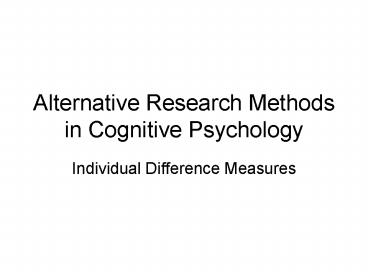Alternative Research Methods in Cognitive Psychology PowerPoint PPT Presentation
1 / 45
Title: Alternative Research Methods in Cognitive Psychology
1
Alternative Research Methods in Cognitive
Psychology
- Individual Difference Measures
2
Comprehension of 3D Anatomical Structures
3
(No Transcript)
4
Arrow View
5
Spatial Ability Measures
- Mental Rotation Test (Vandenberg Kuse, 1978)
- Guays Visualization of Views (Eliot Smith,
1983) - Scores were aggregated
6
Low spatial
Slice 10
High spatial
7
Coding of Drawings
Number of ducts Outside shape Spatial
relations between the ducts Spatial relation
between duct and outside shape
8
Study 1 Interactive vs. Non-Interactive
Animations
- Interactive group (N30)
- Allowed to rotate and pause the visualization at
will during the task - Motion-based depth cues
- Can access arrow view at will
- Non-interactive group (N30)
- Presented with a continuous looping rotation
during the task - Motion-based depth cues
9
Interactive group (N30) Allowed to rotate and
pause the visualization at will during the
task Non-interactive group (N30) Presented with
a continuous looping rotation during the task
10
Interpretation
- Interactivity seems to help performance
- What was it that helped the interactive subjects
do the problem-solving? - Control per se OR what they got to see?
- These groups did not see the same thing
- Interactive and non-interactive subjects received
different visual information - Need to match the visual input
11
Study 2 Yoked-Design
- Remove confound
- Examine the effects of interactivity
- Ensure active and passive viewers see same visual
information
- Predictions
- Interactivity will confer an advantage
- Active participants will do better than passive
- Performance will be related to spatial ability
12
Method
- Between-subjects design N 60
- Spatial abilities measured
- MRT, Guay Test
- Randomly allocated to
- Active condition
- Passive condition
- Yoked pairs of participants
- Active participants controlled computer model via
InterSense Inertiacube2 - Movements were recorded
- Later played back to a passive participant
- Visual information identical
13
Intertia Cube
- 3 DOF inertial orientation tracking system by
InterSense
14
(No Transcript)
15
(No Transcript)
16
Results
No advantage to active participants
Relationship between performance and spatial
ability attenuated
17
Discussion
- No benefit from active control
- Finding was replicated
- How can we account for all our results?
- Does interactivity really help?
- Maybe the key variable is not interactivity per
se, but what the viewer sees - Active control allows the viewer to select
relevant view for solving the problem
18
Access of Arrow View
19
Access to Arrow View affects Performance
Spatial ability and access to arrow view make
independent contributions to predictions of
performance. Together account for 39 of
variance.
20
Study 3 Arrow Views vs Interactive
- Condition 1 Interactive (intertia cube
interface) - Condition 2 Passive Viewing
- Starts at page view
- Rotates to arrow view
- Jitters at arrow view
21
Arrow Views group performance better than
Interactive group
22
Access of Arrow View
23
Difference due to Low Access Group
24
Summary (Cross-Section Task)
- Highly correlated with spatial ability
- Assisted by an interactive animation, however
- Not all individuals access the most informative
view - Performance also related to access of the most
informative view
25
Summary (Methods)
- Correlational
- Drawings to study mental representations
- Interactivity logs another rich source of data
- Individual differences add another dimension
26
Applications for your future
- User Experience Research
- Local company in UCSB Job Bank (Call Wave) We
are looking for a talented new member of our team
to provide us with quantitative and qualitative
data on users' experience with our products.
Plan, design and conduct user research including
field studies, user observations, surveys and
focus groups. Synthesize and analyze data on user
behavior and preferences to identify patterns and
trends in utilization. - The successful candidate will have a BA/BS degree
in Ethnography, Anthropology, Human Factors,
Human-Computer Interaction, Cognitive or
Experimental Psychology, Cognitive Science, or
related field. - Youve learned all the rigorous experimental
methods industry does a slapdash job of applying
these but its better than nothing. Go onward and
change the world!
27
Questions?
- khooshabeh_at_psych.ucsb.edu
28
Extra Slides
29
Informal Task Analysis
encode stimulus object
assume arrow perspective
rotate animation
mental perspective taking
mental rotation
imagine part of object cut away
imagine resulting cross section
draw cross section
30
Cross Section Task
Central to Learning anatomy Interpreting
medical images
31
Analyzing Patterns of Interactivity
32
Method of Analysis
- Python simulation program generates a log file
with time-stamped (x, y, z) position data - MATLAB used to generate histogram frequency plots
33
Interactivity Plots
- Plots arranged as pairs in a columnar
- Top, middle, and bottom pairs show (y, z, x)
(yaw, roll, pitch) - Upper plot in the pair has angle on the abscissa
and indicates number of time-bins spent at each
location - Lower plot in each pair has time on the abscissa
and indicates changes over time
34
Start position
Test Page view
Most informative view (arrow view)
35
Yaw
Roll
Pitch
36
(No Transcript)
37
(No Transcript)
38
(No Transcript)
39
(No Transcript)
40
(No Transcript)
41
(No Transcript)
42
(No Transcript)
43
General ConclusionsApplications for Selection
- Performance in a variety of medical tasks is
correlated with spatial ability - Applications for selection
- Low spatials can acquire skills.
- With training effects of spatial ability are
attenuated, - But still there!
- Ability-skill distinction may be artificial
44
Applications for Training
- Promising role for new technologies
- Simulations can be an effective means of
training, minimizing risk to patients - External visualizations can augment internal
visualization - However individual differences in use of
visualizations simulations too - Importance of metacognitive skills
45
Current Directions
- Stereoscopic displays (Petes Minicon Talk)
- Training in internal visualization of cross
sections (Cheryls dissertation) - More effective external visualizations to
minimize disorientation of low-spatial
individuals (with Andy Stull)

